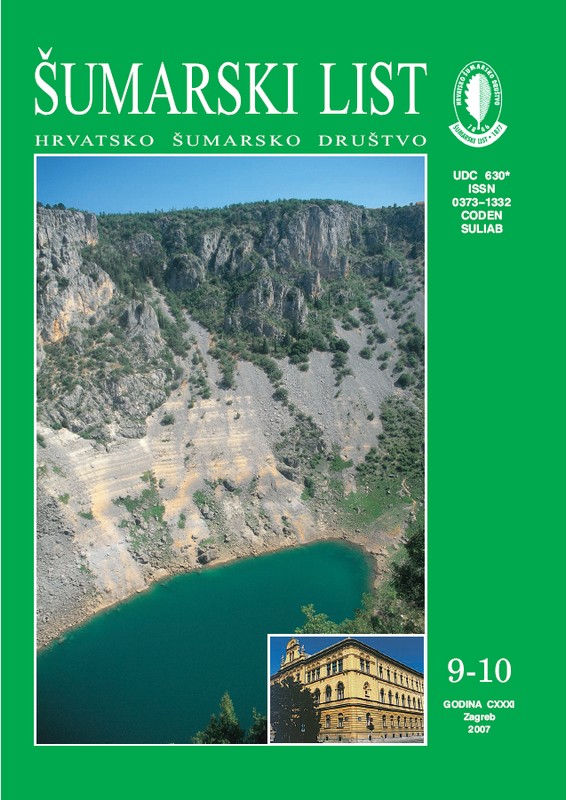
broj: 9-10/2007
pdf (22,5 MB) |
|
||||||||||||||
| RIJEČ GLAVNOGA UREDNIKA | ||
| Branimir Prpić | ||
| Turizam u Hrvatskoj postiže poslije Bljeska i Oluje sve veći uspon, te u gospodarskom razvoju zauzima sve značajnije mjesto. U njegovoj sastavnici, šuma kao infrastrukturna kategorija zauzima značajnu ulogu i to zasigurno puno veću nego što to misle zaduženi za turizam u nas. PDF HR | 406 | |
| IZVORNI ZNANSTVENI ČLANCI | ||
| Vukelić, J., D. Baričević | UDK 630* 188 (001) | |
| Nomenclatural-Syntaxonomic Determination of Pannonian Beech-Fir Forests (Abieti-Fagetum “pannonicum”) in Croatia pdf HR EN | 407 | |
| Trinajstić, I. | UDK 630* 188 (001) | |
| Phytosociological and Syntaxonomic Characteristics of Quercus ilex L. Forests on the Island of Krk pdf HR EN | 431 | |
| Meštrović, Augustin | UDK 630* 231 + 234 (001) | |
| Natural Spreading of the Whitebark Pine (Pinus Heldreichii Christ) and Forming of Pioneer Stands on the Mountan of Čvrsnica in Hercegovina pdf HR EN | 435 | |
| PRETHODNO PRIOPĆENJE | ||
| Pičman, D., I. Rubil, T. Pentek, O. Pičman | UDK 630* 383 + 381 | |
| Soil Stabilisation by Powercem and the Possibility of Implementation in Forest Road Building pdf HR EN | 453 | |
| Summary: So far, in the forest road building, various stabilisation means for improving the bearing capacity of non-bearing forest soils have been used in building forest roads. The stabilisation is particularly used in low-lying forests, where, from the civil engineering point of view, there are many forest soils of poor bearing capacity or non-bearing capacity. Previous chemical methods used lime, cement, various carbohydrate preparations (RRP, WEGS etc.), while lately, there has been a tendency of using various additives. According to chemical characteristics, PowerCem stabilises humus and in this way enables the building of forest roads with the minimum use of stone material. The very use of stabilisation means enabled the lowering of the height of forest road level lines in relation to the classical building method. PowerCem represents the efficient cement additive produced in the Netherlands pursuant to ISO 9001 and 14002 standards. PowerCem is a light grey powder which consists of alkaline and earth alkaline elements, i.e. chosen complex compounds. The chosen components were made on the resistance base where each component contributes to one or more characteristics within the complex chemical and mineralogical process. Apart from the increased resistance to pressure, PowerCem improves the immobilisation of damaging substances which endanger the environment. This includes heavy metals and organic matters which permanently strengthen in new crystal structures. Upon the completion of the stabilisation process, usually after a day, the surface can be burdened by some heavy machine or planned useful layers can be laid down. The final stabiliser quality is achieved in approximately 91 days. In the forest administration Strošinci the soil stabilisation was performed on 28. 09. 2005 by PowerCem on the area of 400 m2. The stabilisation was performed by “Mixed-In-Place” technology. The existing soil is humus with humidity of 35 %. Due to lack of special machines in stabilisation performance, various machines were used: excavator, grader, agricultural fraiser, vibratory roller and cistern. According to data obtained by the examination, i.e. measurement by a circular plate o30 on a trial route, after 24 hours the increase of the compressibility module (Ms) can be seen from the initial 6,80 MN/m2 to 39,50 to 75,00 MN/m2 in relation to the examination position. The last examination carried out after fourteen days shows that the compressibility module is stabilised in a range from 52,60 to 62,50 MN/m2 i.e. about 60 MN/m2. Obtained examination results indicate that the compressibility model of the stabilised forest soil layer corresponds to the smallest compressibility module for ballast bed Ms = MN/m2, and it is far above the smallest value for the classical stabilised soil Ms = 20 MN/m2. The price of building 1 km of the forest road by PowerCem is 131,340 €, while the price of the classically built forest road is 182,960,00 € which represents the saving of 28 % or 51,622.00 €/km. Soil stabilisation by PowerCem application belongs to improved and modernised chemical stabilisation of soil by cement. One of the greatest advantages obtained by this stabilisation is the use of humus, i.e. organic part of soil, which has so far been considered useless. Special machines are used in work and if they are not available, machines which are used in classical stabilisation by cement are used (Pičman, Pentek, 1998). All the advantages of this stabilisation can be divided in four basic groups:
The most important and the most significant quality advantages in relation to the classical building of forest roads are as follows:
Key words: building costs; forest road; non-bearing soil; PowerCem; soil stabilisation | ||
| STRUČNI ČLANCI | ||
| Nikolandić, Đ., D. Degmečić | UDK 630* 156 + 133 | |
| Fertility and Litter Size at Roe Deer (Capreolus Capreolus, L.) in Haljevo Forest pdf HR EN | 465 | |


